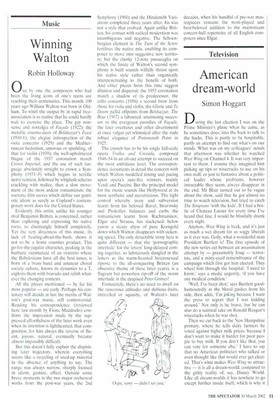Winning Walton
Robin Holloway
One by one the composers who had been the living icons of one's teens are reaching their centenaries. This month 100 years ago William Walton was born in Oldham. To whirl the output by in rapid freeassociation is to realise that he could hardly wait to exorcise the place. The gay nonsense and nostalgia of Facade (1922); the metallic cinema-deco of Belshazzar's Feast (1930-1); the elegiac introspection of the viola concerto (1929) and the Mediterranean hedonism, amorous or sparkling, of that for violin (1939); the well-upholstered blague of the 1937 coronation march Crown Imperial, and the use of such language absolutely straight to crown a Symphony (1931-5) which begins in terrific nervy tension, followed by whiplash scherzo crackling with malice, then a slow movement of the most ardent romanticism; the wartime film scores which define our patriotic idiom as surely as Copland's contemporary work does for the United States.
Evidently this artist, unlike his younger rival Benjamin Britten, is concerned, rather than exploring and expressing his native roots, to disentangle himself completely. Yet the very directness of this music, its lack of beating-about-the-bush, shows it not to be a home counties product. This go-for-the-jugular character, peaking in the barbaric razzmatazz of an oratorio where the Babylonians have all the best tunes, is horn of a brass band and amateur choral society culture, knows its dynamics to a T, exploits them with bravado and relish whatever the changing contexts.
All the pieces mentioned — by far his most popular — are early. Perhaps his centenary will decide at last the merits of Walton's post-war music, still controversial. Reading his correspondence (reviewed here last month by Fiona Maddocks) confirms the impression made by the suppressed effortfulness of the later work even when its intention is lighthearted, that composition, for him always the reverse of fluent, joyous. natural, eventually became almost impossibly difficult.
But this doesn't fully explain the dispiriting later trajectory, wherein everything seems like a recycling of used-up material in the absence of anything to say. The range was always narrow, sharply focused in idiom, gesture, effect. Outside some brave moments in the two major orchestral works from the post-war years, the 2nd Symphony (1960) and the Hindemith Variations completed three years after, his was not a style that evolved. Again unlike Britten, his contact with radical modernism was unambiguous and negative. The Schoenbergian element in The Turn of the Screw fertilises the native mix, enabling its composer to move into suggestive new territory; but the clunky 12-note passacaglia on which the finale of Walton's second symphony is built sounds wilfully thrust upon his native style rather than organically interpenetrating to the benefit of both. And other pieces from this time suggest dilution and dispersal: the 1953 coronation march a shadow of its predecessor, the cello concerto (1956) a second brew from those for viola and violin, the Gloria and Te Darin pallid offprints from Belshazzar, The Bear (1967) a laboured, unamusing successor to the evergreen parodies of Facade, the later overtures and other divertimenti at once vulgar yet whimsical after the rude robust elegance of Portsmouth Point in 1925.
The crunch has to be his single full-scale opera Troilus and Cressida, composed 1948-54 in an alt-out attempt to succeed on the most ambitious level. The correspondence documents in detail the concern with which Walton modelled timing and pacing upon opera's sure-fire winners, mainly Verdi and Puccini. But the principal model for the music sounds like Hollywood at its most synthetic and meretricious. The tight control whereby irony and subversion learnt from his beloved Ravel, Stravinsky and Prokofiev balances and curbs the romanticism learnt from Rachmaninov, Elgar and Strauss, has slackened: below yawns a sleazy abyss of pure Korngold down which Walton disappears with sickening speed. The only detectable irony here is quite different — that the 'pornographic interlude for the lovers long-delayed coming together, so lubriciously dangled in the letters as the warm-hearted heterosexual riposte to the all-conquering Britten (an obsessive theme of these later years), is a flagrant but powerless rip-off of the storm interlude in the despised Peter Grimes!
Fortunately, there's no need to dwell on the rancorous attitudes and dubious fruits, shrivelled or squashy, of Walton's later decades, when his handful of pre-war masterpieces remains the most-played and best-beloved addition to the mainstream concert-hall repertoire of all English composers since Elgar.


































































 Previous page
Previous page